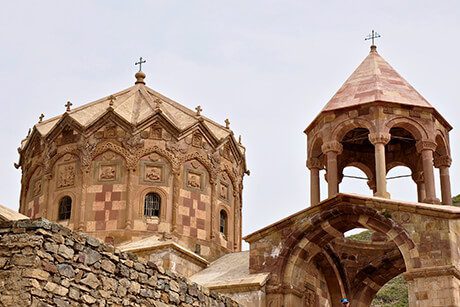Armenian Monastic Ensembles of Iran
Armenian Monastic Ensembles of Iran are one of the most important tourist sites in Iran and are also examples to observe and understand the culture of Iran and Christianity in Iran. On July 8, 2008, the collection of Armenian churches in Iran was inscribed on the UNESCO World Heritage List. This world heritage consists of three churches in northwestern Iran: Qarah Church, Saint Stephen Church, and Dzordzor Church. These three churches were built between the seventh and fourteenth centuries.
These churches have been rebuilt many times over time, but nevertheless, the remains of these three churches are very beautiful and impressive and causes a large number of tourists from all over the world to travel to Iran to visit these churches every year.
St. Thaddeus Church in West Azerbaijan Province
Qara Church (the Church of St. Thaddeus or the Church of Tatavus) known as the first church in the Christian world, is one of the religious attractions of West Azerbaijan, located 20 km from Chaldoran.
The church was built on the tomb of Tataeus, one of the apostles of Christ, and its construction, according to available documents, dates back to the time after Tataeus was killed by the successor of the King of Armenia. This church is known among the Armenians as the Holy Thaddeus, and historians of the eighth century AH and later in their works have called it Qarah church. However, the use of the word Qara for this church, which means black in Turkish, is thought to be due to the use of black stone in its construction.
Qara Kelisa has beautiful and eye-catching architecture and is famous among Iranian churches and has unique features. One of the most important features of this church is the decoration of this ancient work with the stories of Shahnameh, which has given a special beauty to this work. The technique of this church is one of the rarest of its kind in the field of visual arts and it shows that it was made by experienced and skillful artists.
The exterior of Qarah Church has interesting and beautiful architectural designs including paintings of flowers and plants, human images, animal shapes, and motifs containing historical events. Due to the architectural features of this historic building, the presence of defensive walls around the church and its main entrance indicated that this building is also a castle. In the four directions of the castle, there are five watchtowers in the shape of an arch.
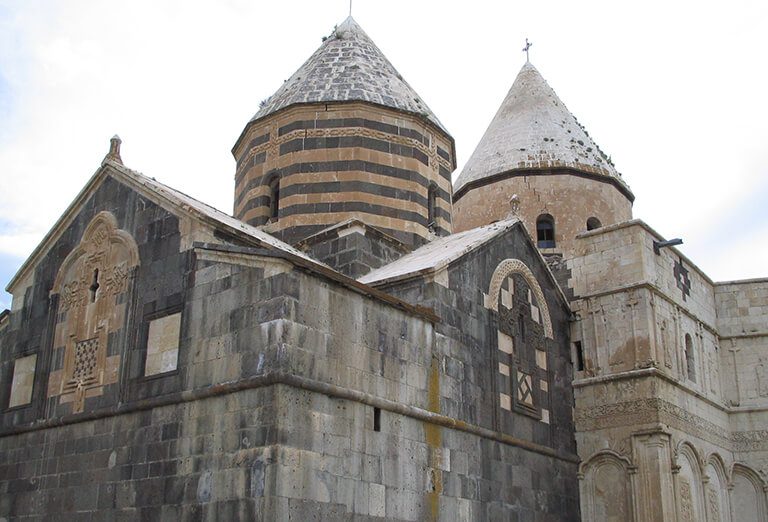
The Qarah church has been looted and destroyed many times over the years and has been badly damaged by natural disasters such as earthquakes. The invasion of the Mongols and their successors, the invasion of Timur Lang, the invasion of the Ottoman army and the civil wars of Azerbaijan have caused great damage to this building.
For the first time, a large part of Qarah church was destroyed during the Mongol invasion of Genghis Khan. However, during the reign of Hulagu Khan, this church was restored by Khajeh Nasir al-Din Tusi. Also in the 14th century (1319 AD) a terrible earthquake destroyed the building of this church and the existing building was repaired and rebuilt by Bishop Zakaria and two of his brothers named Peter and Sarkis in a period of 10 years. The church was also rebuilt with black stones in 1691 and with white stones in 1810 by order of Simon Beznoni.
Saint Stephen Church in East Azerbaijan province
Saint Stepanos Monastery is a church that is located in the middle of the mountains in the border region of Julfa and the Republic of Azerbaijan. The name of this church is taken from the apostles of Jesus Christ and it has many fans so that Armenians go to this church one day a year to visit and perform special ceremonies, which coincides with the death of one of the Christian apostles named Tataeus from the 1st to the 14th of August.
St. Stephen was one of the apostles of Christ and the first Christian missionaries to be stoned. The scene of his stoning is engraved on the south wall of St. Stephen Church. This person is known among Christians because he was one of the first martyrs of the Church and Christianity.
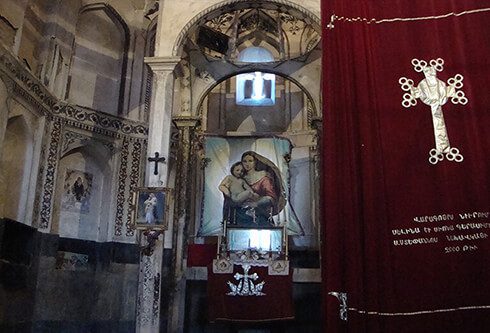
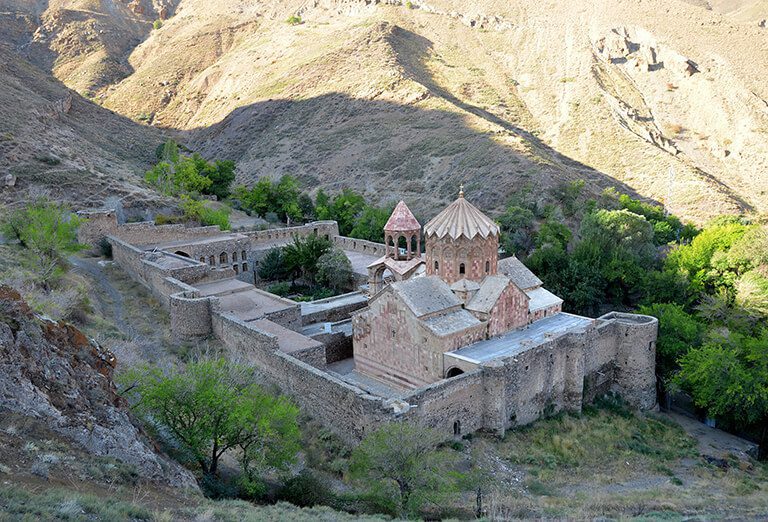
The exact date of construction of St. Stephen Church is not known, but referring to the oldest relevant documents in this place, we can guess that the construction of this church dates back to 649 AD.
The Church is a cylindrical building with a conical dome and a stone fence and seven guard towers, which are built in the heart of the mountain and in a green area with pink, red and white stones. In fact, the church is a combination of Urartian, Parthian, and Roman architecture. The exterior walls of the church are also carved with stones and the interior walls of the church are also covered with plaster and it also has beautiful paintings.
Dzordzor Church in west Azarbaijan province
The Church of the Blessed Virgin Mary or the Church of Dzordzor is the name of a church located in the province of West Azerbaijan, Mako city, near the village of Baron. The date of construction of Dzordzor is estimated between 1315 and 1324 AD.
The plan of the Church of the Blessed Virgin Mary is cruciform both inside and out and has a 16-sided dome with four skylights. Apart from the skylights of the dome, four skylights are built on four walls and the only entrance to the church is from the west side. The materials used in the church are stone and mortar. After relocating the church to the top of a hill overlooking the lake, they built it on a plateau and restored the parts of the church that had been destroyed in their original location using new stones.
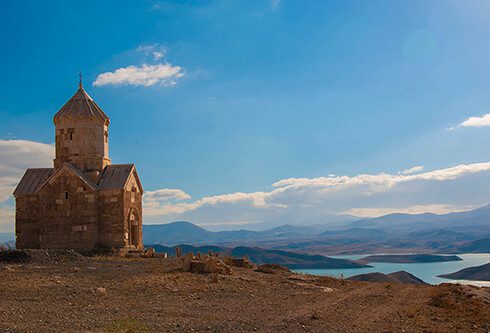
The church is almost square in shape with sides of about 4 meters, the height of the church from the floor is about 7 meters. It has a metal door on which is written in Armenian script Zour Zour and below this inscription a cross is engraved and also on a number of stones of the church wall, the cross is engraved. The church has been carefully restored and despite the good foundation that has been used for the strength of the building, the old stones have been used efficiently in the reconstruction. Stones that did not belong to the main building are distinguished by white.
These three churches are very important because they represent the exchanges of cultures in the region such as Byzantine, Orthodox, and Persian. Armenian churches in the whole geographical area of Iran and belong to all historical periods have a single cultural identity and it should be called the architecture of the Armenian Church in Iran. If you are interested in visiting the Armenian monastic ensembles of Iran, you can tailor-made your desired tours by clicking the button below and buy your tours from to Iran tour website and enjoy your trip.
